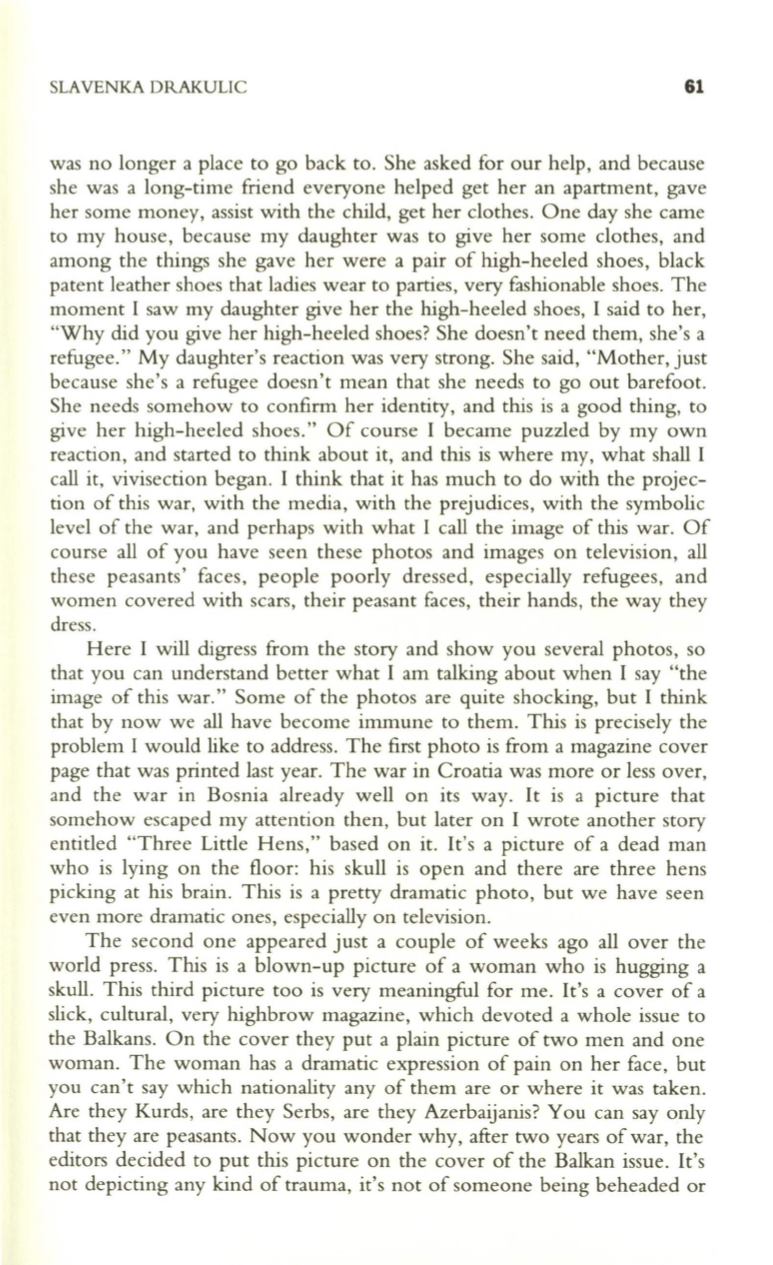
SLAVENKA DRAKULIC
61
was no longer a place to go back to. She asked for our help, and because
she was a long-time friend everyone helped get her an apartment, gave
her some money, assist with the child, get her clothes. One day she came
to my house, because my daughter was to give her some clothes, and
among the things she gave her were a pair of high-heeled shoes, black
patent leather shoes that ladies wear to parties, very fashionable shoes. The
moment I saw my daughter give her the high-heeled shoes, I said to her,
"Why did you give her high-heeled shoes? She doesn't need them, she's a
refugee." My daughter's reaction was very strong. She said, "Mother, just
because she's a refugee doesn't mean that she needs to go out barefoot.
She needs somehow to confirm her identity, and this is a good thing, to
give her high-heeled shoes." Of course I became puzzled by my own
reaction, and started to think about it, and this is where my, what shall I
call it, vivisection began. I think that it has much to do with the projec–
tion of this war, with the media, with the prejudices, with the symbolic
level of the war, and perhaps with what I call the image of this war. Of
course
all
of you have seen these photos and images on television,
all
these peasants' faces, people poorly dressed, especially refugees, and
women covered with scars, their peasant faces, their hands, the way they
dress.
Here I will digress from the story and show you several photos, so
that you can understand better what I am talking about when I say "the
image of this war." Some of the photos are quite shocking, but I think
that by now we
all
have become immune to them. This is precisely the
problem I would like to address. The first photo is from a magazine cover
page that was printed last year. The war in Croatia was more or less over,
and the war in Bosnia already well on its way. It is a picture that
somehow escaped my attention then, but later on I wrote another story
entitled "Three Little Hens," based on it. It's a picture of a dead man
who is lying on the floor: his skull is open and there are three hens
picking at his brain. This is a pretty dramatic photo, but we have seen
even more dramatic ones, especially on television.
The second one appeared just a couple of weeks ago all over the
world press. This is a blown-up picture of a woman who is hugging a
skull. This third picture too is very meaningful for me. It's a cover of a
slick, cultural, very highbrow magazine, which devoted a whole issue to
the Balkans. On the cover they put a plain picture of two men and one
woman. The woman has a dramatic expression of pain on her face, but
you can't say which nationality any of them are or where it was taken.
Are they Kurds, are they Serbs, are they Azerbaijanis? You can say only
that they are peasants. Now you wonder why, after two years of war, the
editors decided to put this picture on the cover of the Balkan issue. It's
not depicting any kind of trauma, it's not of someone being beheaded or


